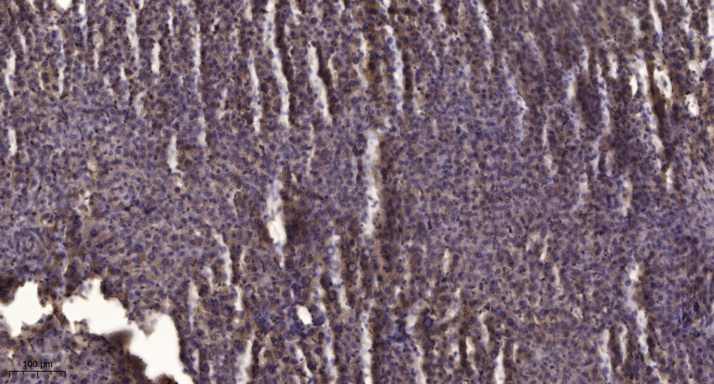PGI2 synthase Polyclonal Antibody
- Catalog No.:YT3690
- Applications:WB;ELISA;IHC
- Reactivity:Human;Mouse;Rat
- Target:
- PGI2 synthase
- Fields:
- >>Arachidonic acid metabolism;>>Metabolic pathways
- Gene Name:
- PTGIS
- Protein Name:
- Prostacyclin synthase
- Human Gene Id:
- 5740
- Human Swiss Prot No:
- Q16647
- Mouse Gene Id:
- 19223
- Mouse Swiss Prot No:
- O35074
- Rat Gene Id:
- 25527
- Rat Swiss Prot No:
- Q62969
- Immunogen:
- Synthesized peptide derived from the C-terminal region of human PGI2 synthase.
- Specificity:
- PGI2 synthase Polyclonal Antibody detects endogenous levels of PGI2 synthase protein.
- Formulation:
- Liquid in PBS containing 50% glycerol, 0.5% BSA and 0.02% sodium azide.
- Source:
- Polyclonal, Rabbit,IgG
- Dilution:
- WB 1:500-2000;IHC 1:50-300; ELISA 2000-20000
- Purification:
- The antibody was affinity-purified from rabbit antiserum by affinity-chromatography using epitope-specific immunogen.
- Concentration:
- 1 mg/ml
- Storage Stability:
- -15°C to -25°C/1 year(Do not lower than -25°C)
- Other Name:
- PTGIS;CYP8;CYP8A1;Prostacyclin synthase;Prostaglandin I2 synthase
- Observed Band(KD):
- 57kD
- Background:
- This gene encodes a member of the cytochrome P450 superfamily of enzymes. The cytochrome P450 proteins are monooxygenases which catalyze many reactions involved in drug metabolism and synthesis of cholesterol, steroids and other lipids. However, this protein is considered a member of the cytochrome P450 superfamily on the basis of sequence similarity rather than functional similarity. This endoplasmic reticulum membrane protein catalyzes the conversion of prostglandin H2 to prostacyclin (prostaglandin I2), a potent vasodilator and inhibitor of platelet aggregation. An imbalance of prostacyclin and its physiological antagonist thromboxane A2 contribute to the development of myocardial infarction, stroke, and atherosclerosis. [provided by RefSeq, Jul 2008],
- Function:
- catalytic activity:(5Z,13E)-(15S)-9-alpha,11-alpha-epidioxy-15-hydroxyprosta-5,13-dienoate = (5Z,13E)-(15S)-6,9-alpha-epoxy-11-alpha,15-dihydroxyprosta-5,13-dienoate.,cofactor:Heme group.,function:Catalyzes the isomerization of prostaglandin H2 to prostacyclin (= prostaglandin I2).,online information:CYP8A1 alleles,similarity:Belongs to the cytochrome P450 family.,tissue specificity:Widely expressed; particularly abundant in ovary, heart, skeletal muscle, lung and prostate.,
- Subcellular Location:
- Endoplasmic reticulum membrane ; Single-pass membrane protein .
- Expression:
- Widely expressed; particularly abundant in ovary, heart, skeletal muscle, lung and prostate.
Effects of Lipid Metabolism-Related Genes PTGIS and HRASLS on Phenotype, Prognosis, and Tumor Immunity in Lung Squamous Cell Carcinoma Oxidative Medicine and Cellular Longevity Minghui Wang WB,IHC Human Human normal lung epithelial cells (BEAS-2B),human LUSC cells
- June 19-2018
- WESTERN IMMUNOBLOTTING PROTOCOL
- June 19-2018
- IMMUNOHISTOCHEMISTRY-PARAFFIN PROTOCOL
- June 19-2018
- IMMUNOFLUORESCENCE PROTOCOL
- September 08-2020
- FLOW-CYTOMEYRT-PROTOCOL
- May 20-2022
- Cell-Based ELISA│解您多样本WB检测之困扰
- July 13-2018
- CELL-BASED-ELISA-PROTOCOL-FOR-ACETYL-PROTEIN
- July 13-2018
- CELL-BASED-ELISA-PROTOCOL-FOR-PHOSPHO-PROTEIN
- July 13-2018
- Antibody-FAQs
- Products Images

- Immunohistochemical analysis of paraffin-embedded human liver cancer. 1, Antibody was diluted at 1:200(4° overnight). 2, Tris-EDTA,pH9.0 was used for antigen retrieval. 3,Secondary antibody was diluted at 1:200(room temperature, 45min).



